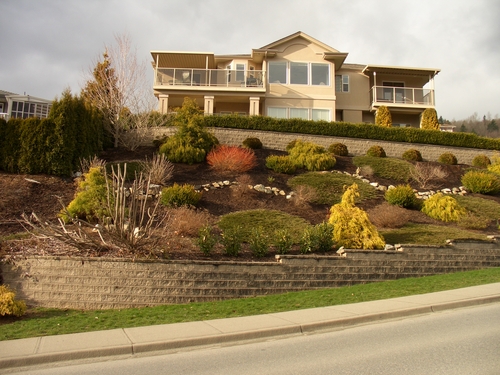There are different types of retaining walls and there is almost always one style that will work for your outdoor space. The appropriateness of a retaining wall depends on factors like yard size, elevation, and drainage of the desired installation area. When you familiarize yourself with the most common retaining wall styles, it will be easier to decide what type of wall you’re interested in having installed, especially with help from an experienced landscape design expert.
The Purpose of a Retaining Wall
Retaining walls are intended to keep sloping, hilly areas of earth firmly in place. These strong, secure structures receive horizontal pressure from natural elements and hardscaping elements, ensuring that the weight that falls upon the retaining wall is held in place.
This hardscaping construction delivers a functional and cosmetic solution for yards that are particularly problematic and suffer from:
- Runoff: Stop soil and water with this draining system that prevents foundation leaks and damage.
- Unusable areas: Improve space that has long seemed wholly unusable by eliminating excessive moisture and sinking.
- Infringement: Reduce the encroaching hillside or slope and create a safe, flat area for a patio or garden.
- Soil erosion: Keep foundation intact by holding back soil.
Types of Retaining Walls for Private Homes
Retaining walls make it possible to create a design that includes freestanding landscaping positioned strategically throughout the yard. From flower beds to patios, areas can be designated as a homeowner sees fit. Some of the most common types of retaining walls include:
- Gravity wall: Typically used in home garden, this is the standard for retaining walls and holds earth back with its weight.
- Piling wall: Metal poles or lumber is driven deep into the ground for exceptional support and the lower portion of this wall is held in place with soil so the wall can withstand a heavy backload.
- Cantilever wall: A cantilever is a horizontal arm that extends into the soil and uses the earth that works against the wall to stabilize itself.
- Anchored wall: The strongest type of retaining wall, this design uses expanding anchors that hold the wall in place with cables.
Elements of a Retaining Wall
While the types of retaining walls have their unique elements that make their identification easy, there are some features that typically common across the board:
- Built higher than 3 feet.
- Building permits required.
- Footing for a secure foundation.
- Draining pipe.
- Stone, brick, or treated timber front.
Retaining walls are not to be confused with garden walls, which are only about 2 feet high or shorter. Garden walls are designed for aesthetics only, softening the hardscape around a yard so there is an attractive combination of soft and hard features.
Landscaping Design in Michigan
A retaining wall delivers beauty and power to land you may have never considered usable. Feel comfortable and safe in your outdoor space with the addition of this hardscape into your landscape. Contact Visionary Landscaping in Shelby Township to discuss your vision and schedule a consultation regarding types of retaining walls.

